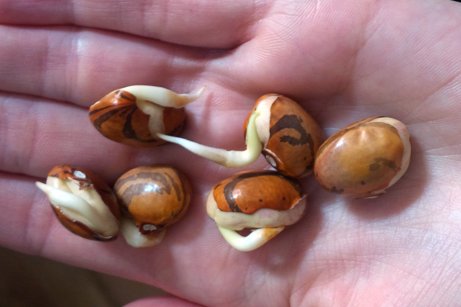A Day in the Life of a Seeds of Diversity Seed

Brittney Glass
Have you ever wondered how we keep our Seed Library organized and up-to-date here at Seeds of Diversity? Well, we thought we would give you a little insight into how we do things. With the large volume of seeds that we receive, we have to make sure they all end up in the right places.
When a new package of seeds comes to us, our first step is to determine whether or not we already have that variety in storage. The Seed Library has two types of storage: permanent (dehydrated and stored in a deep-freezer) and temporary (stored at room temperature for easy access). If we already have a significant amount of a variety in permanent storage, we put the new seed into temporary storage. If we don’t, the new seed is divided into two, and put in both temporary and permanent storage.
Seeds of Diversity's Seed Library currently contains:
5080 samples of seeds
2540 different varieties
363 varieties fully adopted
All new seeds are weighed, and their gram weight amounts are entered into our online database. We also enter the date of harvest, date received, variety name, cultivar number, and the source of the seed. The seeds either go into envelopes, small jars, or large jars, depending on how many there are. Envelopes and jars that are destined for temporary locations are carefully catalogued, labeled, given a searchable code, and then shelved, until they are used in one of our grow-outs, provided to seed savers for multiplication, or offered to new partner community seed banks.
The next step is to test the quality and viability of the seed. If we have enough seed, we do germination tests before they go into storage. For most seeds, this involves counting out 25 or 50 seeds, rolling them up in moist paper towels, and placing them in a cool, dry place for up to 10 days. We then observe how many have sprouted to get an idea of the germination rate of that sample. This germination rate is very important, particularly for growers who may use the seed to grow commercial crops. The photo above depicts a handful of Kahrake Beans, which germinated very well. The little white sprouts are the part of the bean that would become the stem and eventually the mature plant!
The other half of the seeds go into permanent storage, where they are stored in air-tight glass jars. However, since they will be stored for longer before they are grown out, these seeds must be dehydrated in order to maximize their long-term viability. Dehydration involves removing as much moisture as possible from the seeds before sealing them in storage containers. We do this by laying seeds in silica gel, within a sealed compartment, for one week. Silica gel effectively absorbs all excess moisture in the seeds and the air around them. It can be “recharged” by heating it, so that we can use it again for the next batch of seeds.
It is very important to remove moisture from the seeds before they are stored for a long period of time. Moisture can cause the seeds to become mouldy or possibly even germinate. Once the seeds are dehydrated, they are placed in jars with an airtight seal. From there, they are shipped to our Seed Library partner, Everdale Farm, where they are frozen for future use. This is another reason that drying the seeds is essential: moisture in the seeds can freeze into ice crystals that damage the seed.
So, as you can see, cataloguing our seeds is quite a process! We strive to make sure that every step is done with utmost care, so that we can maintain a diverse and viable collection. This collection wouldn't exist without the work and donations of hundreds of seed savers across the country, and we take our responsibility to store and steward it very seriously.
**
Brittney Glass is an intern at Seeds of Diversity Canada.
Our Seed Library depends on your donations. Adopt a variety to support our ongoing work to save Canada's food biodiversity. You can also adopt a variety as a gift for your favourite gardener.
To find out more about the seed library and to see the complete list of varieties in our collection, visit www.seeds.ca/library. To adopt a seed into the seed library, visit www.seeds.ca/adopt.
Not yet a member?
An annual membership to Seeds of Diversity gives you access to our seed exchange, seed grow-out programs, and our online news.

We depend on donations to do our work.

Thank you for your support!
